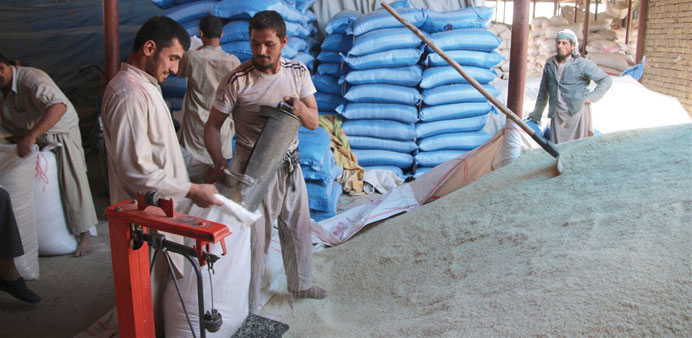By Bilal Sarwary/Chardara District, Afghanistan
Food prices are shooting up in Afghanistan as the harvest has been halted in the country’s breadbasket in the northern province of Kunduz, where farmers have fled fighting and fields are infested with explosives.
The war between pro-government forces and the Taliban has been intensifying in the north. Insurgents briefly took over Kunduz City at the end of September, the first time the group has controlled a provincial capital since being ousted from power in 2001. Thousands fled the capital and surrounding districts as the Afghan army, backed by American forces, fought to retake the area. Many have now returned to their homes, but farmers are still unable to harvest their crops.
“While retreating, the Taliban mined our fields with IEDs (improvised explosive devices),” said Haji Hashim Khan, a 57-year-old farmer in Chardara District, about 10km from Kunduz City. “The crop is ready for harvest but we cannot touch one fruit or vegetable.”
With abundant waters from the Amu Darya River, a sunny climate, and fertile soils, Kunduz Province has been a main supplier to the rest of the country of crops such as wheat, rice, cotton, almonds, potatoes, tomatoes and watermelons.
According to Rabbani Haqiqatpal, director of planning and statistics at the Ministry of Agriculture, Irrigation and Livestock, Afghanistan produced 410,000 tonnes of rice and 4.9mn tonnes of wheat last year. Kunduz contributed 61% of the rice harvest and 12% of the wheat yield.
“Kunduz is a key agricultural province,” he told IRIN. “The fighting there in the past nine months has impacted agricultural trade in the whole of northern Afghanistan and its effect is now being felt even in Kabul.”
Afghanistan has been importing rice and wheat for several years and will have to import even more of the two grains in 2016, causing prices to rise, Haqiqatpal said.
Prices have already increased sharply in the market in Afghanistan’s capital, Kabul, where rice is retailing at 120 afghani (US$1.80) per kg compared to 80 afghani at the same time last year. Wheat is fetching 30 afghani per kg compared with 20 afghani in 2014.
In Chardara and nearby districts of Ali Abad and Khan Abad, the usually bustling agricultural markets are shuttered as farmers have nothing to sell.
While fighting over the past couple months has destroyed the harvest in Kunduz, the farmers’ problems started early in the year as the Taliban began expanding its territorial influence. Fazel Khan, who owns 50 acres near the highway linking Chardara to Kunduz City, said he hadn’t set foot on his farm for seven months.
“The Taliban started gathering on the outskirts of the district around March, just days after I had planted tomatoes and watermelon on my field,” he said. “They drove me and other farmers from the area as they feared we would report their activities to the authorities.”
The 60-year-old said he then started working as a labourer on someone else’s farm, but that didn’t last long. “The Taliban was soon there,” said Khan. “There were daily skirmishes between them and the security forces and we were caught in between.”
The fighting destroyed many fields, as insurgents used them as cover to move positions and Afghan forces fired artillery that burned the crops down, farmers said. In addition to food shortages, the fighting has also led to unemployment in the agricultural sector.
“Farmers, farm labourers, truck drivers - all are now sitting idle,” said Khan Mohamed, a rice farmer in Khan Abad District. “Agriculture is the backbone of Kunduz’s economy. People here either work on the fields or are involved in processing or transporting of farm produce. They have nothing to do now.”
Last October, Mohamed said he sold a tonne of rice for $1,400, which met the needs of his family of 10 for six months. This year, he doesn’t know how they will survive.
Many other families face similar challenges.
“Chronic malnutrition is alarmingly high in Afghanistan,” the World Food Programme said in a September 30 report, which stated that 41% of children under five are malnourished.
Facing a funding shortfall of $30mn, WFP has reduced its food rations for people affected by conflict and natural disasters. The organisation said it was too early to comment on whether the current food shortages and rising prices would affect its programmes.
The number of Afghans considered severely food insecure grew by 317,000 people to almost 6% of the population over the past year, while one in every four Afghans is moderately food insecure, according to a quarterly report up to September by the Afghanistan Food Security Cluster, which is comprised of aid and government agencies. - IRIN

Men fill bags with freshly harvested rice at the rice market in Kunduz where fighting has prevented many farmers from harvesting crops.
